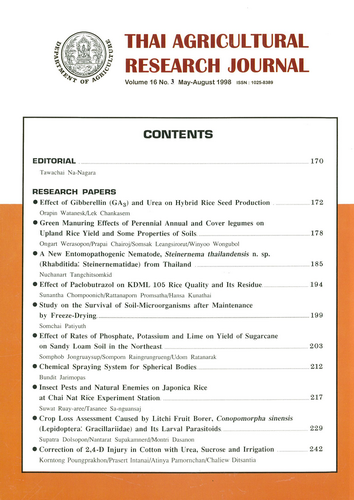Insect Pests and Natural Enemies on Japonica Rice at Chai Nat Rice Experiment Station
DOI:
https://doi.org/10.14456/thaidoa-agres.1998.23Keywords:
Rice insect pests, natural enemies, japonica riceAbstract
The information of insect ecology is necessary and the most important in the IPM. The ecology of rice insect pests in 4 varieties of japonica rice fields, DOA1, DOA2, Todorokiwse and Shiyonishiki, were studied at Chai Nat Rice Experiment Station in dry seson of the year 1996 and 1997. Rice were transplanted without insecticide application. Insect fauna were collected by D-vac machine starting at 3 weeks after transplanting. Then specimen were identified and counted in the laboratory. Damages of insect pests and the occurrence of rice bugs in the heading stage of rice were also investigated. The yields of each rice variety were measured after harvesting.rnThe results revealed low damages of insect pests and no economic loss. The yields obtained are higher than the average. In these japonica rice field conditions, the structure of insect components consisted of case of insect pest, 54% were leafhoppers and planthoppers of which the green leafhoppers, Nephotettix spp. were the most abundant (45%). In 1996, 35% of the insect pests collected were the rice bugs, Leptocorisa spp. Their populations on DOA1 and DOA2 varieties were two times more than those found on Todorokiwse and Shiyonishiki. In 1997, the population of thrips was found about 30% of the total insect pests.rnMost of prasitioids belonged to the order Hymenoptera. In the case of predators, spiders were the most abundant at 70%, but their role showed no significant correlation with leafhoppers and planthoppers. However, there was a significant positive correlation (60%) between spiders and other natural enemies. It means all kinds of natural enemies activated the strengh of biological control of insect pests, and under this condition there is no need to apply insecticides.
Downloads
Published
How to Cite
Issue
Section
License

This work is licensed under a Creative Commons Attribution-NonCommercial-NoDerivatives 4.0 International License.
Thai Agricultural Research Journal



